BY KIT SIMPSON ’27
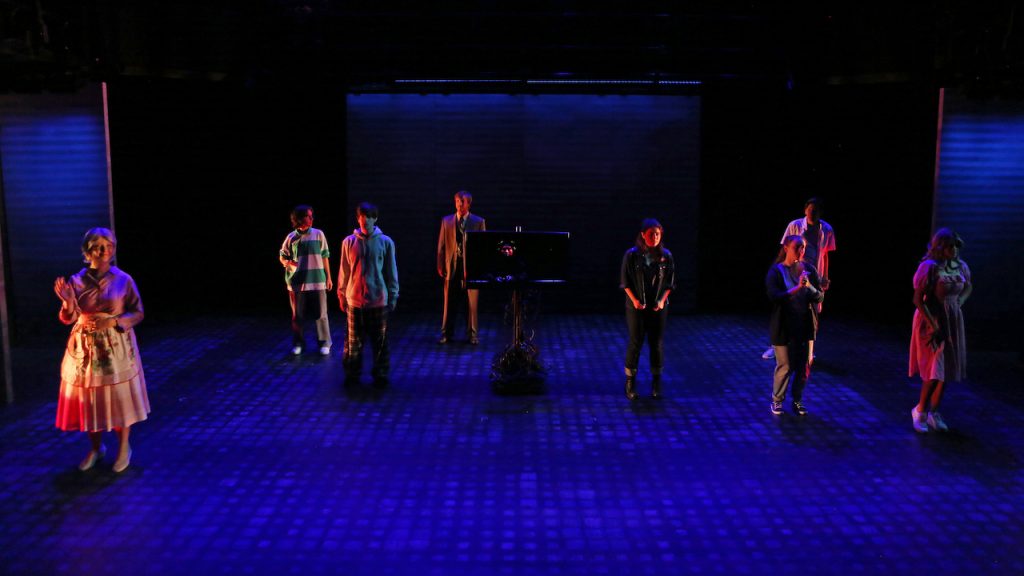
On October 18th, this semester’s black box production, Neighborhood 3: Requisition of Doom, written by Jennifer Haley and directed by Professor Dennis Schebetta, opened.
Before the play began, myself and those sitting around me debriefed about our anxieties surrounding zombies; we were, after all, sitting on the often-discussed “house left,” the part of the audience most apt for jump scares. I warned the English professor to my left that I harbor a crippling case of kinemortophobia that likely stems from a Walking Dead ad seen too young. Before we could psychoanalyze anymore, the lights went dim and a voice from the catwalks started our pre-show announcement. We were about to play Neighborhood 3: Requisition of Doom.
After the pre-show announcement, we heard the first “walkthrough,” performed by Jude Gwak ‘28. The walkthroughs function in a way similar to the Stage Manager in Our Town; that is to say, a liaison between the audience and the play. Inside of Neighborhood 3, the walkthroughs are advice imparted upon players on the best way to win the game. These lines are not directly spoken to the cast, though. Schebetta positions Gwak on a stool atop the Black Box’s catwalk. Gwak’s face also appeared on a tv screen wheeled out by the cast member, bringing them closer to the audience. While the information being shared is perhaps most useful to the players, it still makes the audience feel a little more drawn into the game and world of Neighborhood 3.
After the walkthrough, we open on Makaela (Sophie Kelly ‘25) and Trevor (Jordan Azzinaro ‘26 Oct 18-20, Javier Soto ‘25 Oct 21-23) as they enter Makeala’s home. The interaction starts out awkward–the two were childhood friends who seemingly fell out of contact–but slowly turns more uncomfortable as Makaela, a Regina George-type mean girl, starts to insult Trevor’s mother, a vitamin peddler who coddles Trevor. He starts to storm out before Makaela gives him a killer piece of information: they have a copy of the game Neighborhood 3. Trevor’s friends only let him watch them play, so he is thrilled to have an opportunity to actually play the game. It soon seems Makaela has only used her family’s possession of Neighborhood 3 to keep Trevor over for longer, as she quickly grills Trevor for the way young men react to the game: she mentions the idea of young men spending way too much time with the bodies of zombies after they bash their head in. While this moment could be interpreted as the typical “video game bad” rhetoric that plagued the early-aughts, it’s clear Haley was interested instead in the way that people relate to video games. In response to Makaela’s critique of the game, Trevor argues that it’s nice to have an environment to be sick. This is not a comment on the game—there are plenty of violent video games feature sickening murders. However, it requires a desire to be sick to have the response that Trevor has to Neighborhood 3. The scene ends with Makaela implying that the game is going to reach out and get him, a sinister foreshadowing for events to come.
We then shift to a scene between two parents: Leslie (Andie Alcorn ‘25) and Steve (Jimmy Katzmann ‘25). Steve apologizes for breaking Leslie’s garden gnome. We also learn that both Leslie and Steve are having a rough go with their respective families: Leslie’s family is staging an intervention for her husband’s drinking, and Steve’s wife has left the picture. These problems are not helped by their children’s fascination with the game Neighborhood 3. They learn all of their children have seemingly become twisted by the game; Leslie’s daughter Madison decided to go as “Tinkerbell: Bride of Satan” for Halloween the year prior and Steve feels like he doesn’t even recognize his daughter Chelsea anymore. Leslie continues to confide in Steve about her anger surrounding the intervention, and, eventually, the two part ways. Steve offers to fix the gnome, but Leslie claims that it is the gnome’s time. The stage goes dark and we end on a still life of Steve and Leslie staring at the gnome, which Leslie is holding in a maternal fashion, with great solemnity. It was at this moment that I was particularly struck by the almost bare stage representing the driveway. As I laid my eyes on Steve and Leslie alone, looking down upon the garden gnome, completely alone, I suddenly was struck with great amounts of empathy for these two parents alone, trying to cope with the fact that it seems like it is something in their lives’s “time.”
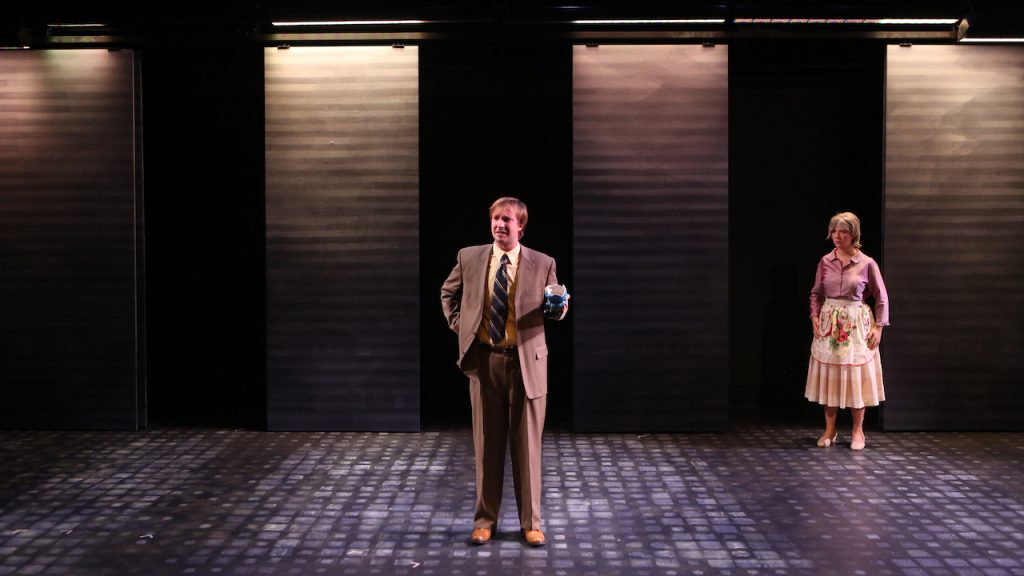
The actors bring on the next set, and now we see another mother, Vicki, played by Andie Alcorn ‘25, and Kaitlyn, played by Isadora Zucker ‘25. Kaitlyn has appeared at Vicki’s home to retrieve something from her ex-boyfriend Tyler–coincidentally, also Makaela from a few scenes earlier’s brother. The two have a light-hearted but tense catch up. Vicki offers Kaitlyn a glass of wine, and Kaitlyn coldly accepts. Vicki is clearly a standard “wine mom” archetype, with over-the-top motions and a kimono that makes her feel right off the set of Mamma Mia. Alcorn does an excellent job of playing Vicki immediately after Leslie; the two women are undoubtedly a far cry from one another, and Alcorn manages the balance with grace. In turn, Kaitlyn is a clearly shaken character. Haley alludes to her having a negative home life compared to the apparent utopia of Vicki’s home, and she is also visibly upset with the way that Neighborhood 3 is making people act; she implies, for instance, that the state of disarray a recently deceased neighborhood cat was found in has something to do with the game
When Kaitlyn inevitably makes it clear that the game and its effects on Tyler is directly responsible for their breakup, Vicki shuts down and defends her family, saying “I quit my job to be home for him.” The tension of the moment — highlighted by the skill of both Alcorn and Zucker — seems to rest on the idea that what Vicki has sacrificed for her children wasn’t enough. She quit her job, and based on Makaela’s scene one declaration that if she acts like “a giant jerk circling the drain” she can get her father to buy her an expensive car, it seems that their father has also catered to them greatly. The scene cuts off with Vicki declaring that she gives Tyler “everything he needs,” only reinforcing her defensive nature throughout the scene’s end.
Meanwhile, the walkthrough is blending the world of the game and the character’s livelihoods. What began as something akin to easter eggs or references—mentions of elements of previous scenes like garden gnomes appear in previous walkthroughs–become more clear. In this walkthrough, we are instructed about how to leave the cat mentioned in the previous scene half-alive, despite any tortured meowing. Here, the play truly moves into horror territory, as the converging of violent fantasy and reality is unnerves my psyche.
The next scene ties very closely to the walkthrough; we get to know the Hendersons as father Doug (Jimmy Katzmann ‘25) and son Ryan (Garin Miner Drewes ‘28) talk about Ryan’s depressive state, clearly connected to the recent death of their cat. The two are situated on the catwalk, a spot usually reserved for Gwak’s walkthroughs. There is distance between them for much of the scene: while Doug is standing up, overlooking an implied pool, Ryan sits in a borderline fetal position, hands clutched to his chest as he cries out most of his lines. Katzmann puts on a Jason-Sudeikis-as-Ted-Lasso-esque accent as he delivers folksy quotes from literature; lines from Walden are provided to comfort Ryan over the death of his cat. (“Snickers didn’t go to the woods” “Well, he went into the bushes a lot” is a particularly charming moment in a particularly dark play.) Ryan and Doug have perhaps the most communicative relationship of any parent and child in the show. So what could possibly go wrong when a father comforts a son? Evidently, suggesting one moves on. When Doug tries to imply that the solution to Ryan’s problem is to return to his chores, Ryan gets upset and tells his father that he is afraid of the pool barracuda. He then further breaks down, and, in a roundabout sort of way, admits that he and his Neighborhood 3 obsessed friends are all responsible for the death of their beloved pet cat. After this, Doug begins monologuing about his sister, a sensitive young girl, who scared him as a child with her incessant crying and moaning. The implication underlying this scene is that Doug’s sister is a monster, and, in turn, so is Ryan.
Haley says in her script notes that “Doug is not a calculated sadist; his behavior arises from fear.” Katzmann does a good job portraying this—his Doug does not feel like an angry man waiting to strike, but rather a frustrated parent finally breaking down after noticing a particular pattern in his son. Miner Drewes also seems to be a son at the brink of a breakdown; shaky breaths and slight movements match the all-consuming guilt that one who accidentally killed their cat may be feeling.
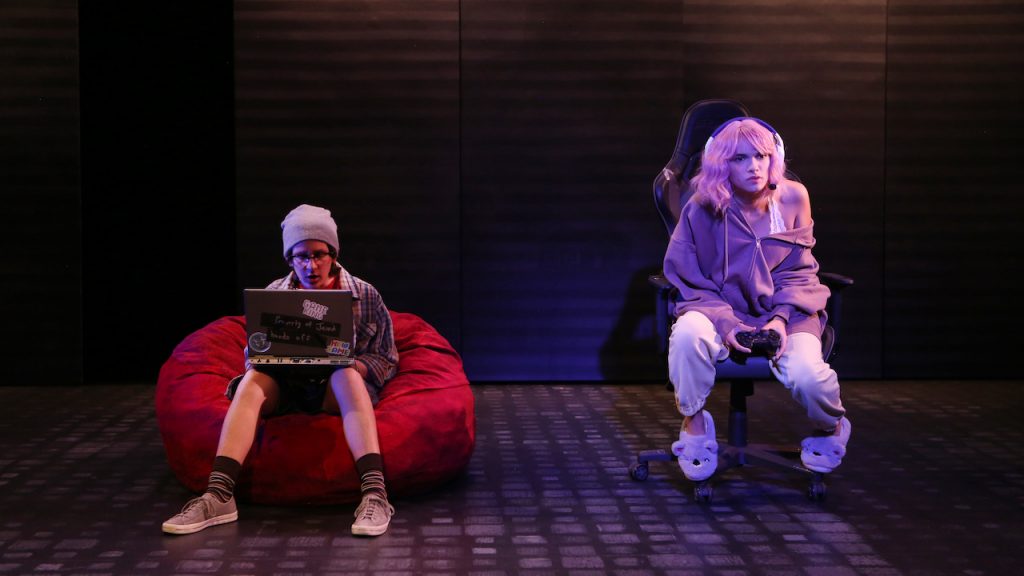
In the next scene, we meet Leslie’s twin children, Madison (Sophie Kelly ‘25) and Jared (Jordan Azzinaro ‘26 Oct 18-20, Javier Soto ‘25 Oct 21-23). Madison is another teenager obsessed with Neighborhood 3, while Jared gave the game up after being creeped out by the “Final House.” The language surrounding the game Neighborhood 3 implies a lack of agency. Phrases like “gave it up” and “you’re hooked” make it sound like Neighborhood 3 is something like a drug. This is especially interesting when juxtaposed against the circumstances of Madison and Jared’s life at the moment. In the scene, they are awaiting their father’s arrival from work so they can begin their intervention. It is instantly clear the two of them are handling their father’s alcoholism in different ways; Madison seems to be angry at him, while Jared is almost despondent. Kelly does an excellent job of showcasing Madison’s anger and humanity in tandem; her range as an actress is such that she can jump from cursing and screaming at her brother to swinging her feet in celebration in mere seconds. Madison also spends much of the scene with her mind away from the real matter at hand. Her gaming group has reached the often discussed “Final House,” or the last level of Neighborhood 3. The very same “Final House” that scared Jared out of playing the game. Her friend Chelsea’s headset has died. Madison, desperate for any aid, turns to angrily reminding Jared that their father has bullied him relentlessly while drunk, even if Jared would never admit it. Sirens are heard outside, only further adding to the unease brought forth in the scene.
It is in this moment where in-game anxiety and out-of-game anxiety seem to converge. Madison’s anxiety and anger is not just rooted in her relationship with her father, it also comes from not being sure what exactly is happening in the game. The end of the scene involves Jared logging on to help Madison defeat the final house. As they approach the house and open the door in game, they hear a noise downstairs and register that their father has returned and the intervention must begin. All at once, their two greatest sources of anxiety set in. As an audience member, I felt a sense of doom. What was going to happen to Madison and Jared? How would their father react to the intervention? Would they make it in the final house?
The next vignette, featuring Jimmy Katzmann ‘25 as Tobias and Andie Alcorn ‘25 as Barbara, is perhaps more linguistically unnerving than all those before it. Tobias seems to play the role of a non-playable character, or NPC. He has no actual affiliation with those playing the game, only there to engage in repetitive actions and disseminate information. Thus, he does not communicate in the same way Barbara would, as Barbara is undoubtedly a facet of the real world. When Barbara begs questions about her son Cody’s whereabouts, all Tobias can muster is a gentle “I’ve seen him come and go.” This is duly uncomfortable, given Cody’s current state is one of supreme distress. In the game, he has reached the final house and has seemingly gone on some sort of rampage because of it. Tobias is aware of this and also has information on Cody’s state of distress. Granted, the extent of this knowledge seems to be that the screaming heard didn’t sound particularly pleasant.
Katzmann’s nonchalance while delivering these lines is what makes it as uncomfortable as it is; he is sharing deeply troubling information about Barbara’s child, all the while talking in a monotonous tone. This nonchalance is further pushed when Barbara and Tobias discuss Tobias’ three deceased children, who are a set of triplets, dead in the womb, that Tobias imagines dancing as ballerinas across the house’s cleanly cut grass. Barbara reveals that the town has a rumor Tobias has killed his children, and that she agrees with the rumor. Tobias never denies the rumor; he does share that he could feel the neighborhood “warping” his children in the womb. He also believes Cody to be a monster with blood out for his parents, and implies that if she sees her son, she shouldn’t “hesitate.” Obviously, the implication here is that Tobias killed his children. And yet, Katzmann continues speaking in a casual tone, all the while Alcorn’s tone remains frantic and crazed. The intertwining of reality and the game figures coming together adds to the chaos and anxiety that seem to be present from scene five on as we inch towards the Final House.
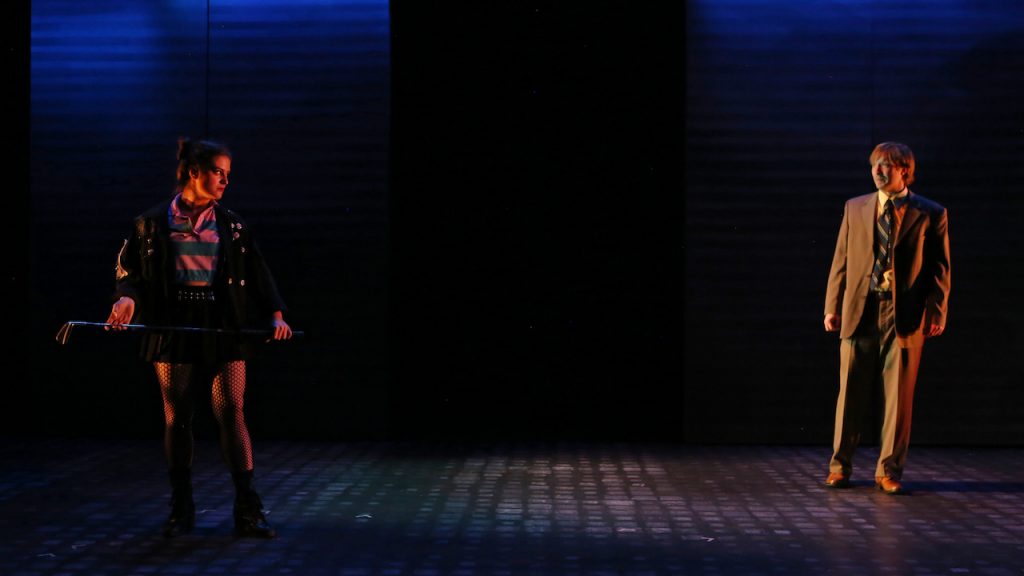
In the next scene, chaos has broken out on the main street. Chelsea (Isadora Zucker ‘25) and Steve meet up outside of their driveway. Chelsea is frantic, trying to find her phone, which Steve has in his possession. Steve, disheartened by his daughter’s emotional absence, went through her phone and discovered lewd photos. As he tries to confront her, Chelsea reveals that Tyler, a character from earlier in the play, has reached “The Final House” and attacked his mother. Steve does not seem to care about this, still fixated on the pictures found on Chelsea’s phone. The entire interaction is markedly tense as Steve tries to piece together what exactly it is that led to his daughter taking these pictures. Eventually, the truth comes out. Chelsea has been taking these photos and exchanging them for in-game currency. It’s not hard to feel sympathetic for Steve, an obviously struggling parent whose wife has just recently left the picture. It’s also not hard to feel empathy for the gruff Chelsea, who clearly just wants to thrive in both the worlds of the game and reality.
The scene ends with a striking and fatal slip of the tongue from Steve: “you used to be so pretty.” Chelsea, a self-described in-game “Level 90 Gothic Cheerleader with a plus 12 proficiency in the golf club,” lifts up a previously unseen golf club and swings it at her father. We end on a frozen moment of Chelsea holding the club above her father, and while there is no blood present and we never see the swing, the implication is clear; Chelsea, overwrought with anger, has taken her own father’s life.
Scene eight begins as normal. Barbara is wandering on the stage, still on the hunt for Cody, when she bumps into an inhuman figure speaking nearly in text talk who introduces himself as “Zombiekillr14.” Based on commentary, Barbara realizes that she inside of her son’s game. Zombiekillr14 soon introduces himself as Blake, a friend from the neighborhood. However, Zombiekillr14 does not look like Blake in any way; he is physically demanding at a prominent six and a half feet tall, carries a baseball bat, a hammer, and sports a combination bicycle helmet/mohawk. Zombiekillr14 and Barbara quickly bond, even if Barbara is clearly a “noob” unaware of how to survive Neighborhood 3. Then, in typical horror movie fashion, there’s a blackout. There’s a surprising amount of levity in this otherwise incredibly frightening scene, notedly through a series of moments where Zombiekillr14 goes “AFK” (away from keyboard). Barbara thankfully has a flashlight, so the two are able to endure for a little while.
As the scene progresses and Barbara and Zombiekillr14 continue on their journey, they eventually come across zombies of their own. Schebetta’s zombies force the audience to experience them alongside Barbara, as their entrance involves a cast member banging on the side of the left wall. After the banging alerts Zombiekillr14, Barbara and the audience of their arrival, every cast member we have seen thus far, save for Alcorn and Miner Drewes, appears onstage in a zombified version of a former character. Having the zombies be characters we have already gotten to know allows for them to feel even scarier, as the audience is likely to feel a greater connection with them.

The scene takes a great shift in its very last moments, wherein Zombiekillr14, for a reason not totally made clear to the audience, lifts up his hammer and strikes Barbara with it. Similar to Steve’s murder at the end of the previous scene, we never see any actual bloodshed, only a still image of the Zombiekillr14 holding his weapon over Barbara at the very end. The lack of bloodshed in a play about violent video games may seem surprising–after all, nothing goes together quite like blood and zombie killing. However, the slight ambiguity presented in these deaths—did they really die? Or did something happen right before they could, potentially sparing these poor parents?—almost makes them more terrifying. Additionally, the actors staying frozen in position pre-murder makes the audience observe the terrifying psychological aspect of the play: children killing their parents.
The shift from scene eight to scene nine is perhaps the most stark. Here, the previously entirely blank stage opens to expose a typical zombie-obsessed teenager’s room. Even the formatting of the scene in the script is different from those which came before; while the rest of the play is stage directionless and formatted like an Emily Dickinson poem, scene nine has proper stage directions and formatting. It’s clear just from this slight change that this scene is going to be markedly different from the scenes before it
This difference is only furthered once lights come up on a teenage boy we have never seen before, played by Matthew Bukzin ‘28, who we soon learn is Zombiekillr14. In walks his mother, Joy (Georgie Svrcek ’25) begging him to come downstairs and watch an episode of CSI with her. Blake is, as every child in this play is, resistant. Joy is also visibly shaken by a noise of some sort outside. She leaves, but not before returning to ask Blake to look outside for her, eventually snapping and telling her son that he only has five minutes left in his game. This is unfortunate timing for Blake, who is just about to go in the final house.
Joy doesn’t give him the whole five minutes, coming back holding a bloody hammer to declare Barbara dead on the side of the street. This is confirmation of an anxiety illuminating the whole play: that the graphic events of Neighborhood 3 are happening in real life. Blake, upon realizing that he has murdered his friend’s mother, begins to panic and begs his mother to give him his hammer. Joy says that she will as long as he tells her–like he means it–that he knows that she has been trying to reach out and understand him. The two almost reconcile their differences, but before Joy can apologize, paranoia sets in and Blake murders his own mother. This death, which was marvelously and hauntingly acted by Svrcek, is much bloodier than the rest, and we watch as blood spatters across the wall of the bedroom, making us as the audience serve as helpless bystanders to the untimely demise of Joy. The realism of this scene juxtaposed with the somewhat hazy reality of the rest of the play is what makes it deeply terrifying; we can write off much of what happens to Barbara and Steve as “all just part of the game,” but when it comes time for Joy to go, we cannot deny any longer.
The final scene of the play is Blake calling for his mother, suddenly unsure of if what he has done is reality. A grim end to a grim play.
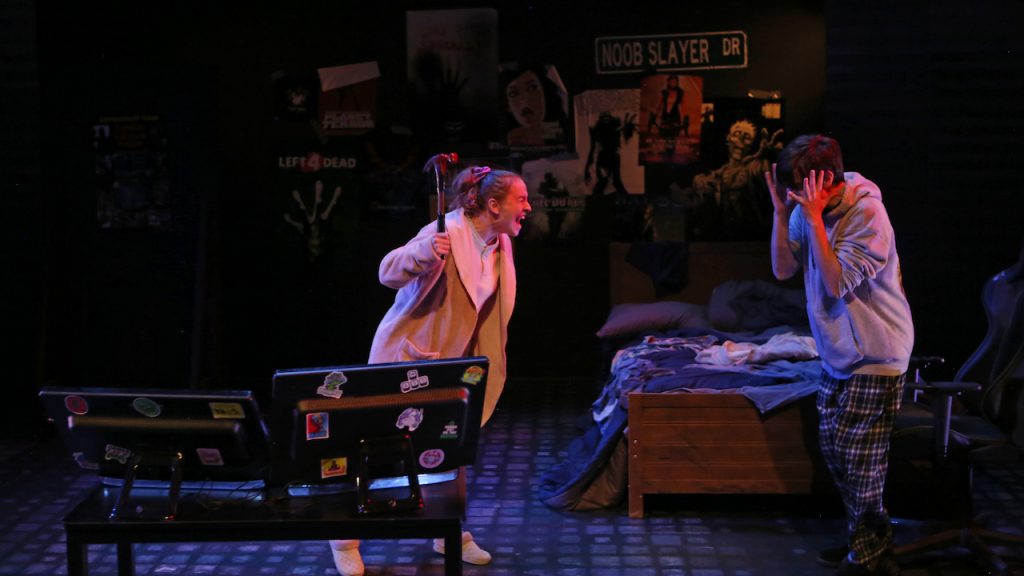
I left the theater, deeply terrified and debating whether or not it was too late at night to spontaneously text my parents that I love them without causing alarm. Then, I googled “requisition” to make sure I had the definition right. The formal definition is “an official order laying claim to the use of property or materials.” I certainly feel Schebetta’s production of Neighborhood 3: Requisition of Doom laid claim to my inner feelings of doom, even if just for eighty minutes.
Photos by Sue Kessler
***
Kiersten Simpson ’27 is the Editor-in-Chief of the Skidmore Theater Living Newsletter
